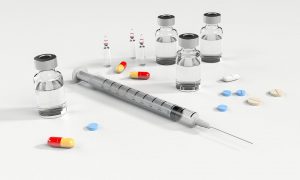By Michaël Cousin
Translation: Lawrence Myers
Passage au crible n°96
On September 25, 2013, the IRACM (Institute of Research Against Counterfeit Medicine) presented a report on counterfeit medicine as organized crime. This study intended to better expose the phenomenon, but also to provoke reflections and to provide the tools needed to protect oneself from it.
> Historical background
> Theoretical framework
> Analysis
> References

Pixabay
For a long time, medicine has been spared from counterfeiting despite the globalization of national economies and the expansion of communication techniques. However, according to the IRACM, global prescription drug fraud allegedly began the moment the USSR collapsed. It seems to have intensified when China became a member of the WTO (World Trade Organization). The distribution of counterfeit medicine apparently became so significant that it may have even surpassed the sale of legal products by 20% between 2005-2010. Even if this phenomenon appears to be global, it more so concerns developing countries. According to the IRACM report, 10% of prescription drugs sold in such countries may be counterfeited versus only 1% in developed countries.
These falsified substances don several characteristics. It generally concerns copies of legal, non-generic substances. Most of them prove to be poorly dosed or in poorly packed. Certain ones contain no active principle, while others may even contain toxic substances. Furthermore, all types of medicine are concerned: antiseptics, painkillers or anti-inflammatories, but also vital products like antiretroviral drugs (HIV, Hepatitis C, etc.). As a case in point, the analysis reveals that in the 90 states receiving false treatments for malaria and tuberculosis, there are regrettably 700,000 deaths annually.
In most cases, clients become the accomplices of the counterfeiters. Yet, in the trafficking of imitation drugs, the buyer acts for his own account, therefore putting his life at stake. This is why IRACM qualifies this type of counterfeiting as organized crime. It is structured around many actors – from the individual to organized crime – and on different scales, from the small group to transnational organizations. For that matter, due to the liberalization of markets and the growth of communication methods, traffickers have numerous means of infiltration available to them including cyber criminality. But certain counterfeiters also use official distribution networks to the point that health professionals – notably pharmacists – are themselves as deceived as patients.
1. The social determinants of health. The health of individual is affected by several factors such as the environment in which they grow and develop, from birth to old age, their living and working conditions as well as the quality of the healthcare systems available to them. As it happens, public policies play a predominant role in this area because they are themselves conditioned by relationships of money, power and resources available at the local, national and global level.
2. The commercialization of health in favor of organized crime. In a neoliberal economic context, the privatization of drugs on the world scale – both in terms of their production and distribution – permits a maximization of profits. Criminal organizations, as well as individuals, then benefit from the competition between medical treatments delivered by firms in order to offer counterfeit products that are more competitive in terms of price, but are less efficient. The effect is to guarantee their high profitability.
Illegal companies present themselves as legitimate businesses. They too are looking to sell products and to ensure the best financial gain possible. In order to do so, they resort to management techniques that are as well developed as they are effective. Finally, they employ competent staff while at the same time being careful to refinance and to recycle their treasury. In this case, the counterfeiting of drugs proves to be more profitable than legal production because it avoids all investment in research and development. Additionally, their manufacturing does not meet any quality standards (poor conditions, insufficient packaging, no active principal, etc.) and remains clandestine.
In this respect, Carol Reed’s British thriller, The Third Man, remains paradigmatic. Viewers see traffickers profiting from a shortage of penicillin in a post-war Vienna to sell the drug in a more diluted form. Like those in Vienna, today’s counterfeiters also thrive on poverty or the impoverishment of populations attracted by treatment at a lower cost. In the same way, modern day traffickers benefit from the consumers’ lack of information and the weakness of border controls.
For want of possessing an efficient system of physical or immaterial control, States suffer from current border openings, which unquestionably facilitate the work of criminal organizations. Such organizations capitalize on the deregulation of national economies and their virtual counterparts (market financialization) in order to distribute their production around the globe. An increase in the number of steps of manufacturing of false therapeutic substances complicates the struggle against them. Added to this is the use of tax havens in order to launder the profits from this prohibited trade.
The difference between these criminals and pharmaceutical companies lies in the methods used to achieve their goals. Admittedly, corruption is present in both entities, but the legal industries do not use violence as a means to enter markets. However, these negotiations are not solely built on the domination over all actors, they can develop by the involvement of those seeking benefits. In this respect, let us recall that individuals sometimes sell products via a virtual pharmacy without knowing their quality or origin. As for local politicians or government employees, we have already seen cases of their facilitating the trafficking of counterfeit drugs within official distribution systems (hospitals, pharmacies, medical visits, etc.) with the avowed objective of receiving clandestine services or better salaries in return.
These transgressions are not the only problem that States must contend with. Countries’ financial problems, especially developing ones, distort the proper functioning of their healthcare systems. On the one hand, industrial protection restricts access to the most affordable medications, such as generic brands. On the other hand, their governments cannot substantially commit to the prevention of this transnational criminality. It is true that the Palermo Convention, adopted in the context of the United Nations in December 2000, provides a framework for the reinforcement of police and judicial cooperation on an international scale. However, none of the accompanying protocols (trafficking of persons, migrant and arm smuggling) is exclusively dedicated to this new human disaster.
Institut de Recherche Anti-Contrefaçon des Médicaments, “Contrefaçon de medicaments et organisations criminels,” 2013, link: http://www.iracm.com/2013/09/liracm-presente-un-rapport-detude-inedit-contrefacon-de-medicaments-et-organisations-criminelles/
Organisation Mondiale de la Santé, “Déterminants sociaux de la santé,” link:
http://www.who.int/social_determinants/fr/
Briquet Jean Louis, Favarel-Garrigues Gilles (Éds.), Milieux criminels et pouvoir politique. Les ressorts illicites de l’État, Paris, Karthala, 2008, Coll. Recherche Internationales.
Pouvoirs, “Le crime organisé,” (132), Jan. 2010, pp. 5-137.




